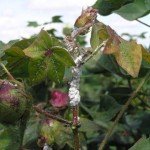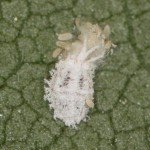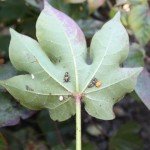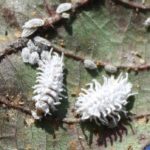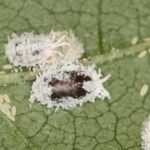Solenopsis mealybug can be found throughout Queensland’s cropping areas and has also been confirmed in Western Australia, the Northern Territory and Victoria. Whilst solenopsis has not yet been confirmed in NSW cotton crops it would be reasonable to assume that it is likely to be present in the broader landscape and it is only a matter of time before it is located in cotton.
- A solenopsis colony
- Solenopsis mealybug with young
This year, a relatively mild winter combined with a wet spring has encouraged higher than usual numbers of wild hosts that support overwintering mealybug populations. As these wild hosts are dying, mealybug are moving onto cotton. Initial infestations are also common on ratoon/volunteer cotton in the field even before the main cotton crop is planted. Surveys have shown a link between mealybug incidence and the presence of alternate hosts.
If you come across small white insects in your cotton, you need to consider:
- Correct identification. While there is a high probability that you have found solenopsis, there are other similar looking species that occasionally occur in cotton but rarely cause crop damage. Solenopsis are 3-4 mm long and have two characteristic dark longitudinal bare spots across their thorax and abdomen. Excellent pictures of solenopsis can be found on the Beatsheet and various cotton extension publications.
- Field condition. Mealybug most commonly occur in situations of back to back cotton, where ratoons or volunteers are present within or nearby to a paddock, or where there are unthrifty plants (usually due to waterlogging or nutritional disorders). However, they can be transferred into a healthy paddock on clothing, machinery, wind or water.
If you think you have found solenopsis it is important that you mark the plant they are on, otherwise it will be hard to find the spot again as solenopsis are very difficult to detect, particularly in low numbers.
There are currently no effective insecticides registered so the only mechanism available for managing this pest is to rely on the biological control provided by natural enemies such as lacewings, ladybird beetles (cryptolaemus and three banded in particular) and mealybug parsitoids. Evidence that natural enemies are present include the eggs and larvae of green lacewings, ladybird eggs, larvae and adults, and the brown pupal cases of parasites in amongst mealybug colonies.
- Ladybird larvae and pupa
- Cryptolaemus larvae eating mealybug
- Parasitised mealybug
Re-checking marked plants will enable you to judge the efficacy of any natural enemies that are present and also provide an indication of the species present when it comes to making future spray decisions and selecting options that best conserve them. Tagged colonies also provide an indication of the potential disruption that a spray decision might have had as mealybug will quickly increase in numbers when natural enemies are removed.
Look for the presence of natural enemies, evidence of predation and parasitism and whether or not the solenopsis colony is growing or dwindling in number. It is highly likely that there will be other colonies elsewhere in the same field, and the information from marked colonies will provide you with a picture to what is occurring in your field at a broader scale.
It is also likely that tagged colonies of mealybugs will disappear between checks due to predation. Again this will provide a measure of natural enemy impact and emphasises that the utmost care must be taken when making spray decisions (particularly for mirids) in order to conserve natural enemies.
The current Cotton Pest Management Guidelines has the most up to date information regarding the relative impacts of the different insecticides currently registered in cotton.
Article by Paul Grundy and Moazzem Khan, Department of Agriculture and Fisheries, Queensland

